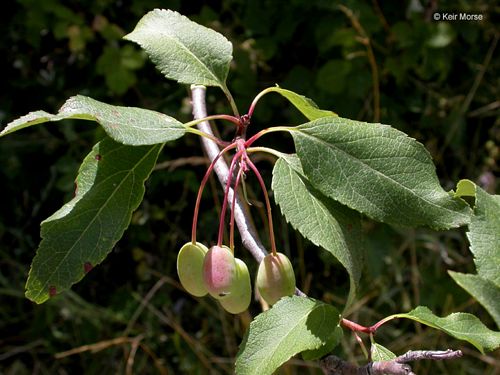
The Western Crabapple. Photo by Ken Morse.
The Pacific Crabapple, Malus fusca, was put in a separate entry because it’s the only crab apple on the west coast of North America from about San Francisco north. It’s a wild apple that manages to survive in Alaska and deserves to be mentioned. (See a separate entry for Wild Apples.)

The western carbapple has a different shape than the eastern crabapple.
This small apple was highly important to indigenous peoples who lived anywhere near the tree. At least 19 groups — mostly coastal — harvested it annually. As of 1990 many were still picking it. A hundred grams of Pacific Crabapple have 90 calories, 1.2 grams of protein, 1.6 grams of fat, 17.7 grams of carbohydrates, and 6 grams of fiber. B vitamins are B1 (thiamin) 0.03 mg, B2 (riboflavin) 001 mg, B 3 (niacin) 1.9 mg. A second study puts the vitamin C level at 8 mg, vitamin A 4 RE and potassium 194 mg. As for the rest of the minerals phosphorus 33 mg, calcium 29 mg, magnesium 28 mg, sodium 21.2 mg, iron 0.6 mg, manganese 0.33 mg, zinc 0.2 mg and copper 500 mcg.
Malus is Dead Latin’s version of Greek Malon/Melon for apple. Fusca means dark, swarthy, dusky. Often called “deer candy” as deer are fond of the fruit.

Distribution map, Pacific Crabapple
IDENTIFICATION: Small tree, leaves irregularly lobed, toothed edges, pointed at the end. Branches have sharp shoots, fragrant apple blossoms white to pink. Fruits are small, to half-inch, oblong unlike eastern crabapples, and yellow to orange to purplish-red. Older bark deeply fissured.
TIME OF YEAR: Late fall to after first frost. Often picked when slightly under ripe to sweeten off the tree. However they turn soft after a frost, turn brown, and become sweeter.
ENVIRONMENT: Moist woods, edges of wetlands, estuaries. Prefers full sun.
METHOD OF PREPARATION: Edible fresh, cooked and preserved. Can be mixed with sweeter fruits, are made into jelly and are a good source of pectin. They were often preserved with fish oil and also served with fish oil (ooligan grease.) Their acid content also helps in their preservation. The bark was used medicinally but contains cyanide-producing compounds.

